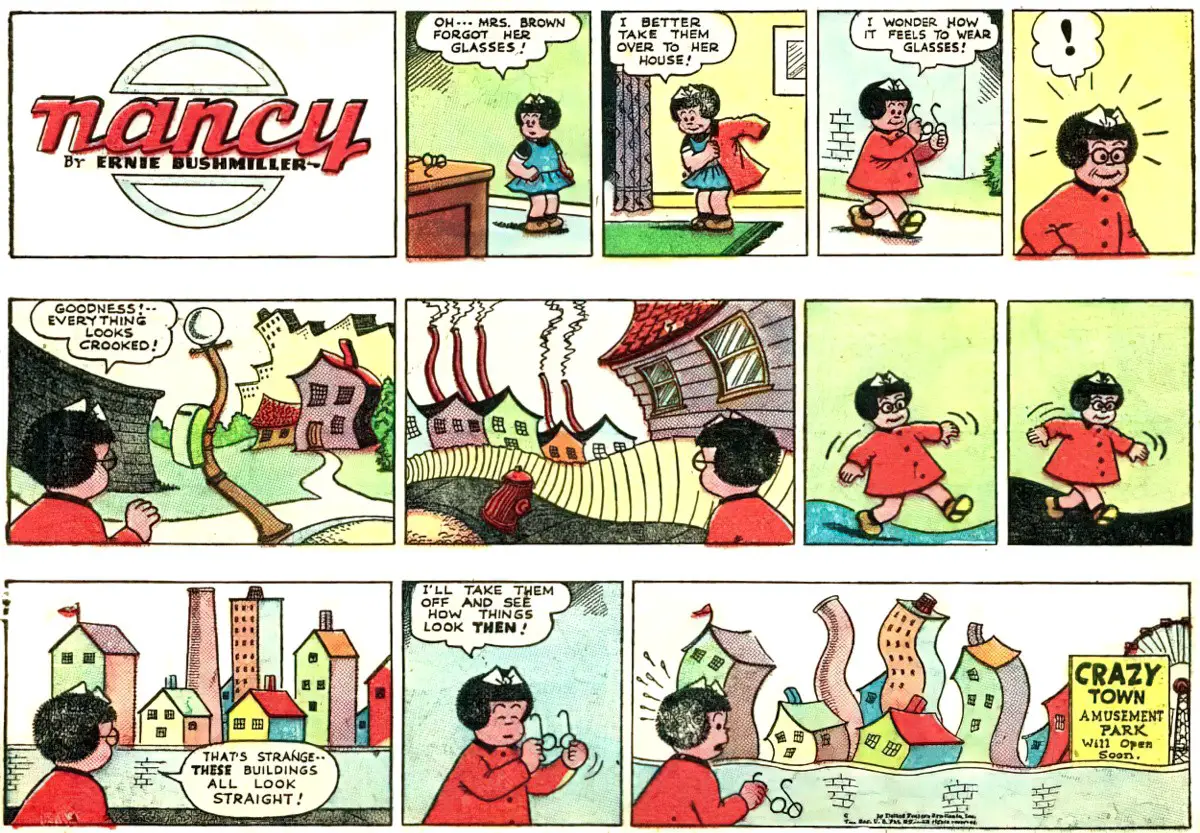I really like Scott Dikkers’ taxonomy of humour categories. Today I’m taking a closer look at why the new Nancy cartoons by the pseudonymous Olivia Jaimes work so well for so many. In short, why are these minimalist snapshots funny?
The strip, about a rambunctious little girl, her buxom aunt, and her tough-talking best friend, was a study in comedy’s bare essentials, using a handful of panels to tell exquisitely crafted jokes, many of which played with the format of the comic strip itself. It began in 1938, as a spinoff of an earlier strip, Fritzi Ritz, about Nancy’s aunt who gradually became a supporting character in her own strip. And it was so ambitiously simple that it inspired a famous work of comics criticism, the 1988 essay (and later book) “How to Read Nancy.”
Vox
(I haven’t read How To Read Nancy, but I’d like to.)
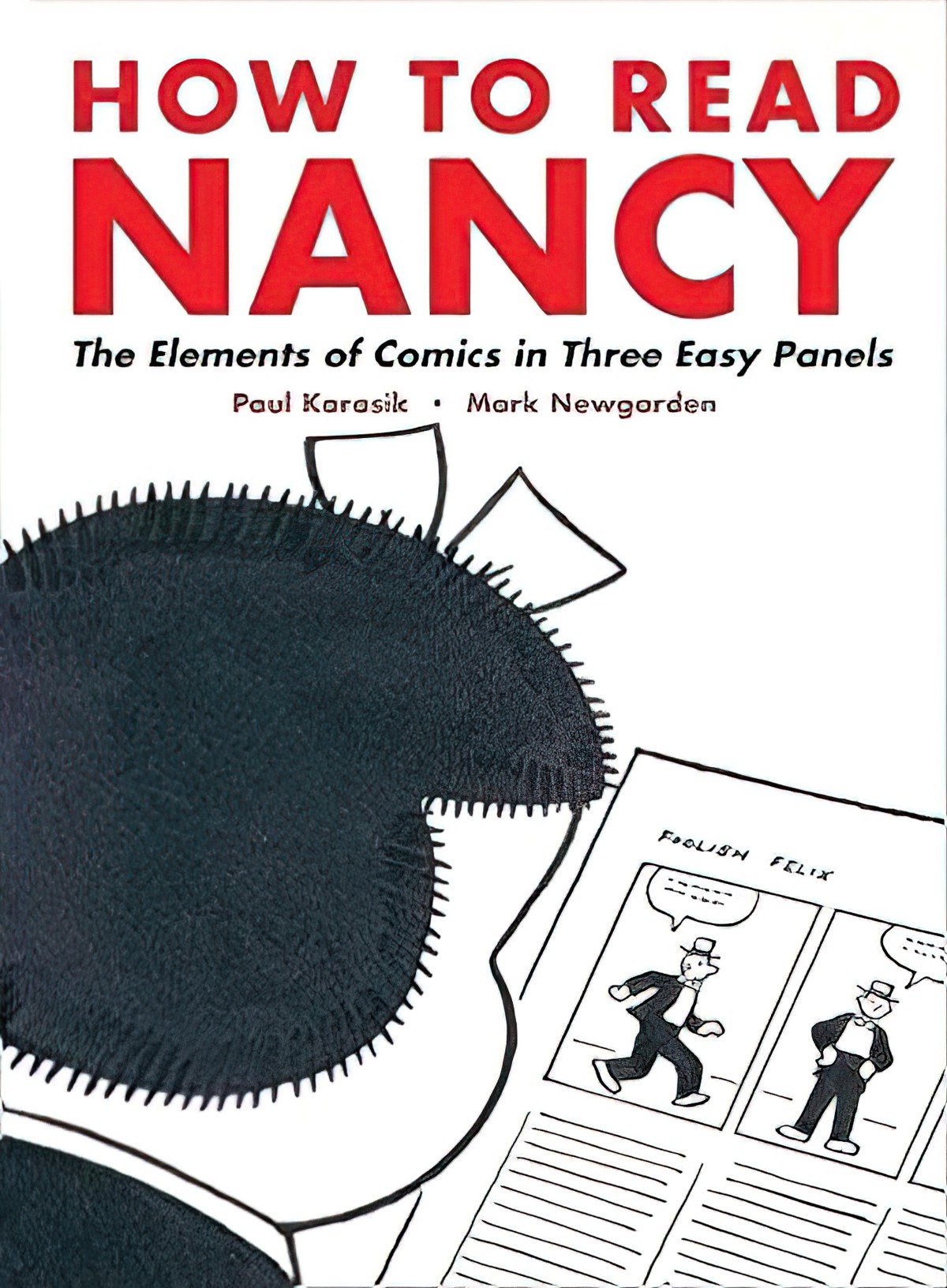
Some points from the book and from enthusiasts:
- To dismiss ‘Nancy’ as a simple strip about a simple slot-nosed kid is to miss the gag completely. ‘Nancy’ appears to be simple only at a simple glance.
- Every element in a “Nancy” panel adheres not to a comic strip but rather to “the blueprint of a comic strip.
- In comics, all action is composition.
- In ‘Nancy,’ Ernie Bushmiller created his own reality, where everything is wholly his and the world as we know it has been reduced to its essentials — there’s a Zen-like mastery of form.
- Unlike a justly venerated classic like ‘Peanuts,’ ‘Nancy’ doesn’t tell us much about what it’s like to be a kid. Instead, ‘Nancy’ tells us what it’s like to be a comic strip.
- There’s an emotional sort of flatness of the stories
- The gags aren’t side-splittingly funny but they are always visually satisfying.
The following strip is considered classic Bushmiller at his peak:

Notice how Nancy is a trickster, observing a situation then getting her own back, with extra on top. (Her opponent uses a water pistol; she is about to make use of an infinite stream of hose water.) The Battle is kept off the strip because we know exactly what’s going to happen.
THE FUNNY FILTERS BY SCOTT DIKKERS
1. Irony – Intended meaning is opposite of literal meaning
Is Nancy ironic? I believe it’s hipster ironic, always aware of irony itself.
[Jaimes says] her comic is “#relatable” — and here I detect a sideways irony in her voice as she pronounces the word hashtag.“The self-hating part that often comes with #relatable comics is being like, ‘Ohhhh, I procrastinated, I’m the worst,’ ” she says. “And ‘Nancy’ adds one more panel to that, being like, ‘Who cares? I don’t care. More corn bread for me.’ ”
Vulture
2019 readers tend to find it ironic that we listen more to the people on the other side of a screen than we do to people sitting proximal to us in the real world, so the following cartoon works on an ironic level, but I do wonder if younger generations won’t start with that expectation — that the person in the room with you cares more about you than people on the other side of a screen. For them, this may not be irony:

2. Character – Comedic character acting on personality traits
Jaimes is a brilliant character writer. Her version of Nancy is all rapacious appetite, unwilling to curb herself in almost any way. (When Jaimes took over the strip in April, the title character was introduced going in on that cornbread.) And Jaimes’s version of Nancy’s long-running foil Sluggo is probably kinder than Nancy, but he also seems to have less patience with his friend’s antics just because she’s the protagonist. Aunt Fritzi, meanwhile, shows a welcome change from the hypersexualized version of Gilchrist’s era — she seems like someone who can’t believe she’s somehow raising her niece but making the best of it anyway.
Vox
“Nancy as a character had drifted from where I envision her,” Jaimes says, “in that the Nancy I know and love is a total jerk and also gluttonous and also has big feelings and voraciously consumes her world. […]
Vulture
Nancy can be overconfident to a ridiculous degree.

She’s also destructive.

3. Reference – Common experiences that audiences can relate to
The technology humour of Nancy is also reference humour. Anyone on Messenger can relate to this one:
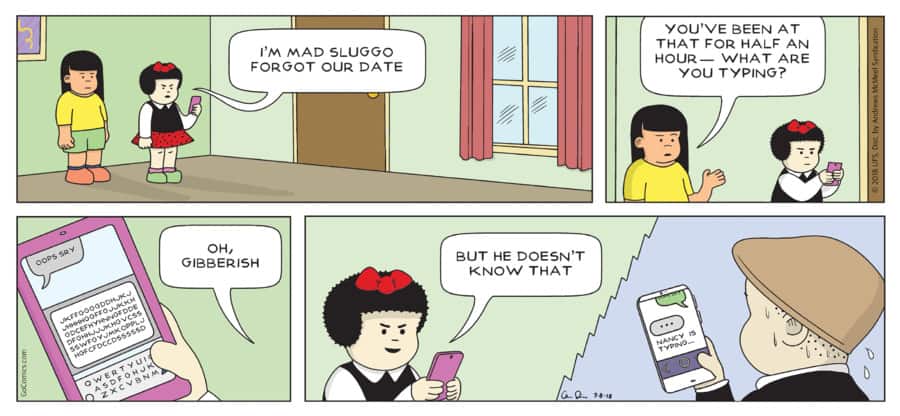
Nancy is perfectly suited to our present moment of cynical hedonism. The character is focused solely on self-satisfaction and stubbornly opposed to anything that gets in her way, and the strip allows readers to see themselves in her tech-addled narcissism and have a laugh at their own expense.
Vulture
You’re going full Black Mirror.
Vulture
This is my plan. “Nancy” is going to become Black Mirror.
4. Shock – Surprising jokes typically involving sex, drugs, gross-out humor, swearing
This is based on something started in the 1930s, so even if the strip had ever used shocking language, it wouldn’t feel shocking today. This is not part of ‘Nancy’.
5. Parody – Mimic a familiar character, trope or cliche in an unfamiliar way
Nancy humour regularly makes fun of our use of technology. Here, our addiction to it, as Nancy is compelled to get out of bed to check an inconsequential message because her phone is charging and she can’t have it in bed right next to her. The general grimness of it is an extra overlay of dark humour.
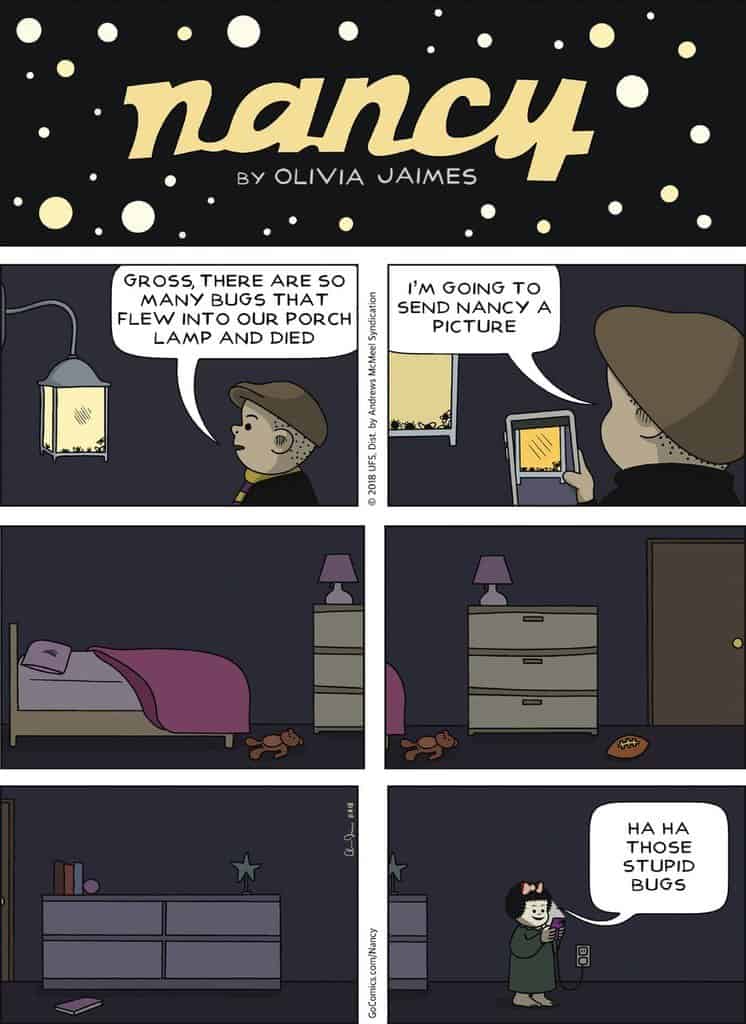
And then there’s the well-known joke that while we’re staring at our screens we’re failing to notice the world around us, to our own detriment.
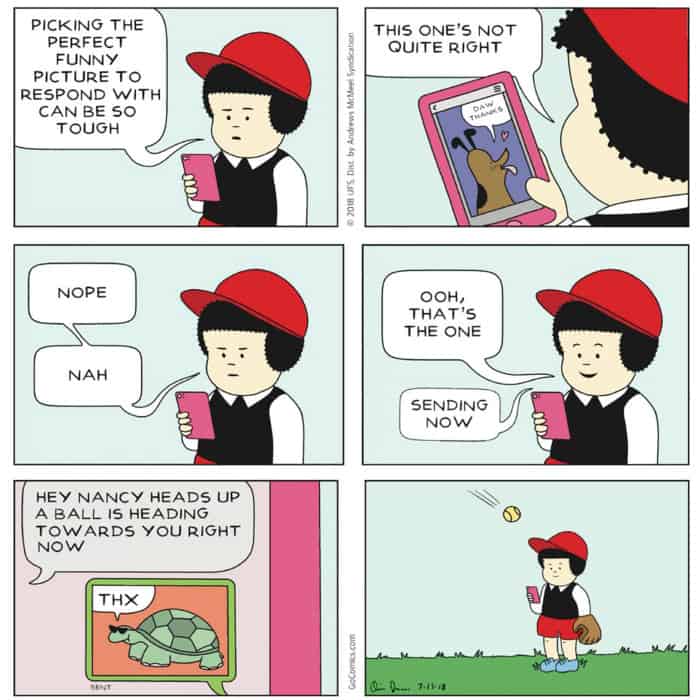
If I hadn’t just watched a documentary on kids who are Instagram famous I wouldn’t get this joke, which describes how keen Instagram users know that at certain times of day their posts will get more likes:

6. Hyperbole – Exaggeration to absurd extremes
While Bushmiller gave Nancy megaphones as gags, Jaimes realised she couldn’t give modern Nancy megaphones. She doesn’t need megaphones because we all use phones for that. The phone itself is hyperbole, but it’s a kind of realistic hyperbole, because we all use them so much:
‘Nancy uses something in a way that’s different than intended,’ ” Jaimes says. “[In Bushmiller’s originals] she’s got, like, a thousand megaphones sitting around her house just waiting to be used creatively in jokes.
Washington Post
I realized that all of the nouns that Nancy used to have are being supplanted by a phone. Things that she would have lying around the house to make up a joke are gone. She uses megaphones for a ton of things in Bushmiller’s strips, and I don’t have megaphones lying around my house. So how, then, can Nancy solve problems, given that technology is advancing to the point where problems are being solved in really nonphysical ways? That’s why I’m making her learn robotics. It opens up a wider range of visual gags to make down the line.
Vulture
7. Wordplay – Puns, rhymes, double entendres, etc.
Wordplay often involves taking a metaphorical extension of a word and making Nancy interpret it more literally, as in the various meanings of ‘move’.

8. Analogy – Comparing two disparate things
This isn’t such an easy concept to understand, so I’ll quote from Dikkers’ book (How To Write Funny):
Analogy is the comparing of two different things and finding their similarities. The two things should be very different—opposites are especially good, and there must be many similarities. It’s finding these connections between the two things and making the reader aware of them that makes Analogy funny. Analogy, like Parody, is slightly more complex than the other Funny Filters. It provides another “hidden secret” in your writing. The secret in Analogy is the half of your Analogy that you keep veiled.
When you compare two things in an Analogy, you only want to overtly reveal one of them to the reader. The other is alluded to, and readers are invited to add two and two to think of it on their own, thanks to your clues.
So far, the closest I’ve found is this example. The real world is compared to the online world which, to Nancy, is more real.

9. Madcap – Crazy, wacky, silly, nonsensical
Jaimes has also updated Nancy in other ways, bringing more characters into the world of the strip, like Nancy’s robotics teacher and her friend Lucy (the girl in the yellow shirt in the comic below). Just the idea of Nancy taking a robotics class is the sort of gag that marks the strip as being written in 2018, but it’s easy to imagine Bushmiller loving it for its ability to create chaos.
Vox

10. Meta-humor – Jokes about jokes, or about the idea of comedy
[Jaimes] constructs jokes patiently, often using the idea of the comics panel itself to make them funny. Consider the comic below, for instance, where Nancy (the little girl with the bow in her hair) and her friend Sluggo remain stationary in the frame, and the action consists entirely of scenery that simply appears around them. Even the old man who has all the dialogue barely changes his facial expressions.
Vox

[E]ven while adding plenty of her own flourishes, Jaimes has smartly returned to one of Bushmiller’s trademark joke structures: Using the format of the comic strip itself to create gags that refer to “the artist” as a weird presence in all of the characters’ lives. (They seem to know, at all times, that they live in a comic strip, but they also seem okay with this.)
Vox





(For more on metafiction, see this post.)
11. Misplaced Focus – Attention is focused on the wrong thing
Deliberately misplaced focus is part of Nancy’s character humour. She interprets answers to her questions as she sees fit.
She also runs on her own internal logic.

Jaimes also uses lots of chestnutty advice and ends it with Nancy having interpreted it in the opposite way from that intended:

But here’s the weird thing I cannot work out about Nancy. This cartoon series has a cult following among grown-ass men who feel weirdly protective about how it is read and interpreted. They have their own Facebook group and argue endlessly about it, dick-waving with each other.
